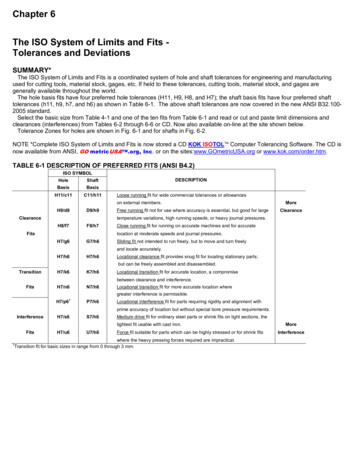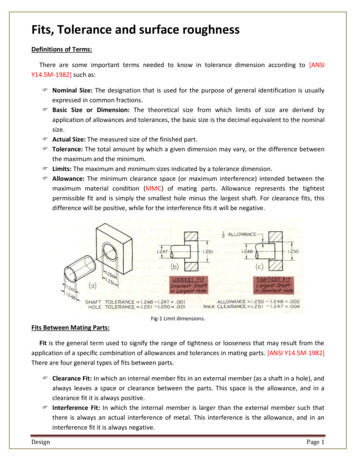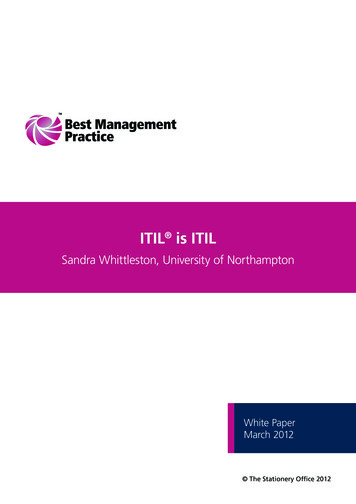
Transcription
White PaperITIL That Fits Your BusinessBy Bridget Conrad, VP Services and Support
ITIL That Fits Your BusinessTable of ContentsIntroduction3What is ITIL?3Adoption of ITILA moving target – The evolving ’best practices’ of ITILImplementing ITIL345Where to beginBasic questions to askStart with the most urgent processes566Software tools – flexibility is the keyAgiloft has the flexibility you needImplementation consultants can save you time and money677Conclusion8
ITIL That Fits Your BusinessIntroductionIn the last several years, ITIL has become abuzzword in management circles. CEO’s and CIO’sanxious to stay at the forefront of business trendshave felt some pressure to adopt “the most widelyaccepted approach to IT service management inthe world.”1 ITIL has been portrayed by some as apanacea that will suddenly make IT a profit center,while improving services, reliability, infrastructure,and accountability.However, jumping into “implementing ITIL” withouta clear understanding of how best to go about itand what potential benefits and pitfalls you mayencounter is tantamount to jumping out of aplane with your company’s resources on your backinstead of a parachute.A significant percentage of ITIL implementationsare simply never completed, after months oftraining, certification tests, and effort, while it is alsocommon to find that an ITIL implementation hasactually increased the workload of IT staff memberswithout improving service or reliability.Both of these outcomes may be avoided by doingsome homework and approaching ITIL with a clearsense of priorities. This paper offers some practicalsuggestions for how to get the greatest benefits ITILhas to offer without getting lost along the way.What is ITIL?The Information Technology InfrastructureLibrary (ITIL) is a set of “best practice” guidelineson managing IT processes that were originallydeveloped for government agencies in the UnitedKingdom in 1989. The guidelines were created byan organization called the Central Computer andTelecommunications Agency (CCTA) in response towhat was perceived as the inefficiencies and failingsof IT in the British government.The purpose of the guidelines was to increaseefficiency and cost-effectiveness, reduce failure,and improve the customer service provided byIT organizations. The agency that created theITIL books investigated the actual practices ofcorporations as well as government agenciesin the UK and abroad, looking for the processelements that led to effective IT service delivery,and they then codified those elements. The ITILbooks therefore documented practices alreadybeing followed to some extent in many successfulorganizations.Adoption of ITILITIL quickly became a well-known standard inEurope and much of the world soon after itsintroduction, thanks in part to the IT ServiceManagement Forum (itSMF), an internationalorganization founded in the early 1990s to spreadthe word about ITIL. The UK and the Netherlandseach created their own ITIL user certificationprograms in 2000 and hundreds of thousands ofindividuals have been certified.ITIL has been slower to gain ground in the UnitedStates. Only in the last 5 years has it made realinroads among American corporations. The lag inAmerican adoption has been blamed by some oncultural differences. Ken Hamilton, past presidentof itSMF in the USA, explains, “Europe tends to bea qualitative environment. Process improvementin terms of the quality of service delivered, thesesorts of metrics were more popular in Europewhereas in the United States, cost savings, returnon investment, hard-dollar savings were theprimary drivers.”2The interest in ITIL adoption in the U.S. has beengrowing, however, as indicated by changing surveyresults. In October 2005, a U.S. survey on theComputer Economics website showed that 56%Chad Vander Veen, “American ITIL”, Jul 27, 2005Government Technology, (http://www.govtech.com/gt/articles/95672?id 95672&full 1&story pg edge-Centre/Best-Practice-Guidance/ITIL/
ITIL That Fits Your Businessof respondents weren’t even familiar with ITIL andanother 11% had no plans to implement it:3Current State of ITIL AdoptionNo Plans11%Researching16%ImplementingIn Place12%6%“What is ITIL”56%0%20%40%60%Percent of RespondentsSource: Computer EconomicsFigure 1By February of 2008, a survey of 370 CIO’sworldwide (100 of them American) by DimensionData found that almost 59% of American CIO’ssaid they had “engaged with” ITIL, but only 8%of them “deemed themselves aligned to theITIL framework).4 Contrast that with 66% oforganizations outside the U.S. engaging withand 17% considering themselves to be truepractitioners of ITIL.The main barriers to adoption cited by thesurvey were the costs associated with training,certification, and implementation. 31% of U.S.CIO’s reported that the framework should be moreactionable, while 25% complained that it shouldbe more flexible. 40% of American CIO’s believedthat ITIL would facilitate innovation by freeing ITdepartments from routine tasks.Most U.S. companies implementing ITIL havebeen large corporations. This is not surprising,3“ITIL Adoption: 2006 Could be Watershed Year inU.S.”, October, 2005, Computer Economics Metrics forIT Management, http://www.computereconomics.com/article.cfm?id 10684since ITIL was originally developed to addressthe problems of large organizations, and many ofthese problems may not even exist for small tomidsized organizations. For instance, a processaimed at improving communication between largedepartments will make little sense in a businesswith fewer than twenty employees. Moving to atightly structured, standards-based approachis most likely to pay off for companies jugglinga variety of independent systems in separatedepartments that don’t talk to each other.However, many small and medium-sized businessescan benefit from implementing the parts of ITILthat apply to them. The key is to find an approachthat takes into account an organization’s individualneeds and goals. For example, in a small businesswith only a few hundred computers, one or twopeople may be responsible for all computersupport issues. They may have little time to focuson higher-order issues like service strategy whenthey spend the workday managing incidents on acase-by-case basis.Implementing certain ITIL practices such as incidentmanagement in the early stages of a business canprepare the IT department for its eventual growth.Additional processes, such as change management,can be added as the business need arises.A moving target –The evolving ’best practices’ of ITILFirst published in several hefty volumes, the initialITIL library has continued to evolve as real worldexperience suggested some changes of emphasis.ITIL V2, published in 2000, is the foundationused by most companies who have implementedITIL to date. Of the 8 main books, the two mostwidely used were those on Service Support andService Delivery.5“Dimension Data Survey Shows More thanHalf of U.S. Organizations Have Engaged withITIL”, Feb. 28, 2008, 21-71F8-4A8D-827F-Enterprise: Instights and Perspectives for the CIO, ula Klein, “ITIL V3 – The Reality Check,” Smart
ITIL That Fits Your BusinessThe latest revision, known as ITIL V3, was intendedto remedy the “one-size-fits-all” approach of V2,and to provide more practical advice. It was aninternational effort, with input from vendors,government agencies, and industry stakeholders.Published in May 2007, V3 was intended to be moreflexible and adaptable to different business models.While V2 focused on processes, V3 emphasizes theway in which services are delivered to the business.The five core titles of ITIL V3 outline a theoreticalapproach to effective IT practice using the conceptof a service lifecycle:Service StrategyHelps IT organizations create strategies toimprove and develop services over timeService DesignProvides best practices for the designof IT services and processesService TransitionDemonstrates how IT organizations can best deliverservices required by the end-user, and manages thetransition of new, modified services to productionService OperationProvides a methodology for delivering effective,consistent levels of service to end-usersContinual Service ImprovementOffers best practices for anticipatingthe end-user’s needs and making appropriateservice changes over timeFor those who have already begun the certification orimplementation process under V2, it is helpful to seehow the services described in V2 map into ITIL V3:66Paula Klein, “ITIL V3 – The Reality Check,” SmartEnterprise: Instights and Perspectives for the 08winter/bestpractices.jhtml)Implementing ITILWhere to beginOne of the challenges with implementing ITIL is thatthe processes described in the ITIL volumes aredescriptions of strategies for system effectiveness,rather than prescriptions for how to implementthem. As a result, even after sending people toexpensive ITIL certification and foundation trainingcourses, your organization may still not have a clearidea of exactly how to implement ITIL.It is a mistake for most companies to try toimplement all the ITIL components at once. Thisis likely to result in endless process debates anddeadlocks, a lengthy and costly implementationproject, and an unfinished or unsatisfactoryresult. While it is certainly beneficial to plan along term ITIL roadmap, it is essential to prioritizethe implementation, and then proceed todesign and implement process improvement inmanageable chunks.
ITIL That Fits Your BusinessBasic questions to askWe recommend that you start by looking at yourmight add. For instance, for many companies, thecost of maintaining a CMDB is higher than thecurrent IT service picture and asking the followingvalue delivered.7questions:The point here is that you should not feel1. Where are the greatest points of pain for ITemployees?compelled to implement everything in thefirst round. The lack of prescription of the ITILguidelines has a silver lining, which is the flexibility2. Where are the greatest points of pain for ITto implement the elements of ITIL that will mostcustomers?benefit your company.3. Are IT staff too busy putting out fires to provideSoftware tools – flexibility is the keygood service?4. Are we gathering enough data to know whatdifferent services are costing us and where ourITIL guidelines are sufficiently broad to allow thelargest enterprises to handle the most complexIT operations. But they can also be used in aemployees are spending most of their time?buffet-style implementation. Most organizations5. If so, where is the majority of time going?Therefore, when choosing a software tool to use for6. Which areas of process improvement would givewon’t implement all of ITIL (nor will they need to).ITIL, flexibility is essential.us the greatest boost in productivity, customerITIL software solutions should be able tosatisfaction, and/or value to our organization?accommodate a variety of approaches whichStart with the most urgent processesOnce you have analyzed your current situation,you should be ready to make some decisionsabout where to start. If your answers to thequestions above are typical, starting with incidentmay change as a business and its goals evolve.Companies looking for a software solution shouldask themselves the following questions:* Can the software be customized to reflect thestructure of our processes?management, service request management, and* Can we use the software to add new processes aschange management will often give the biggestwe become more comfortable with ITIL?bang for the buck.All companies need some way to manage thesebasic issues, and unless you already have aneffective system in place, improving theseprocesses should have immediate benefits that willjustify the budget necessary for the implementationand provide a rapid ROI once implemented.* Can processes and tables be easily linked to eachother to reflect relationships?* Can we use the software to manage just theprocesses we choose to use?* How much of the setup is already done for us,and how easy is it to modify?Let’s suppose that you choose to start with thisIn selecting the appropriate software for yourportion of ITIL. Should you also include Problemimplementation, look for a flexible solution thatManagement, Release Management, and a CMDBallows you to start small and add as you go and that(Configuration Management Database)? Thatmay depend on the size of your organization, the7asset data you are already maintaining, and anDone”, IT Skeptic, 6/26/2006 (http://www.itskeptic.org/analysis of what real value including these elementsitil-cmdb-skeptic)Rob England, “ITIL’s Dead Elephant: CMDB Can’t be
ITIL That Fits Your Businessis easy to modify—since your way of doing ITIL maydiffer from other companies’ methods. There is no“right” way to implement, so any solution that claimsto do it all for you and give it to you complete outof-the-box may not be flexible enough to do whatyou want.Watch out for products that claim to be “ITILcertified.” True ITIL certification applies only toindividuals, not software, so such claims aremisleading at best. Many applications also claimto be ITIL compliant. What does this mean? Again,there is no clear “standard” for ITIL compliance ina software product. In broad terms, a “compliant”product should be one that has all the functionalitynecessary to support ITIL-based processes. Itshould be able to map the complex relationshipsbetween assets (configuration items), people, andthe various kinds of requests (Problems, Changes,Incidents, Service Requests, etc.). It should alsoautomate a variety of processes, ensuring thecorrect procedures are followed, notifying aboutdeadlines and service delivery failures, and so on.However, this may not be enough.Agiloft has the flexibility you needAgiloft was designed with this flexibility in mind.Because of Agiloft’s unique adaptive technology, ittook us just a few weeks to develop our entire outof-the-box ITIL structure. And it takes even less timeto make any changes to fit the precise needs andpreferences of your business.This is only possible because we planned fromthe start to design a product with the full rangeof functionality needed to automate any complexbusiness process, from ITIL to SOX, and fromgovernment compliance applications to CRM.The ideas that shape ITIL’s best practices arefundamentally interwoven into the product.Implementation consultants can save youtime and moneyImplementing any part of the ITIL guidelinesinvolves making many decisions. Most people whohave attended ITIL training classes and becomecertified still do not have the tools and experiencenecessary to actually design an ITIL basedimplementation.Since the ITIL documentation does not tell youhow to construct a service catalogue or how youshould implement the process of converting aservice request into a problem or change request,“ITIL-compliant” software vendors have designedtheir systems to implement ITIL the way they think itshould work.Software vendors are ideally positioned to be ableto assist in an ITIL implementation. If a vendor’sprofessional services team is knowledgeable andconversant with ITIL guidelines as well as expert incustomizing their own software, using their servicescan save you time and money and help ensure asuccessful implementation.But your company may have different needs thanthe company next door, and many pre-configuredITIL products are not flexible enough to let youimplement ITIL the way that is best for yourcompany. You need to ensure that you can easilycustomize your ITIL software to reflect the way youwant to manage your IT services. An ITIL-compliantproduct that does not allow you to change it to meetyour needs will not serve you well. When looking fora product, then, it is critical to find one that has theflexibility to map just the processes you want to useand to support the data model that is right for you.Agiloft’s professional service team has over adecade of experience in designing best practicesupport and helpdesk solutions, all of which foldwell into ITIL. Our customers have repeatedly toldus that one of the greatest benefits of choosingour product was the quality of advice and guidanceprovided by our professional services team.Our ITIL certified team members can help you finda sure path through the ITIL jungle so that you don’tmiss the forest for the trees.
ITIL That Fits Your BusinessConclusionImplementing ITIL, if done right, can improveyour IT service operations and improve yourrelationships with your customers. However, ITIL isnot a panacea for your business. Remember, theguidelines suggest what to do, not how to do it. Youmust make the decisions. Therefore, your entireorganization must get behind ITIL so the decisionswill align with the rest of the organization.It’s surprising how many organizations go into anITIL implementation without fully understandingwhat they’re trying to achieve. It is important to buildWithout fully considering what is best for yourcompany and how to tailor ITIL to your businessneeds, you won’t get an implementation that peoplewant to use, and you may end up with processesthat only a massive government bureaucracycould love.Start small by choosing to work on the mosttroublesome elements for your organization, soyou get the greatest benefit. And be sure whenchoosing a software vendor to find a solution thatwill easily adapt to your needs and that can providethe extensibility you need for the future.consensus about the goal of implementing ITIL.About AgiloftOver 3 million users at organizations ranging from small enterprises to U.S government agencies and Fortune100 companies depend on Agiloft’s top rated product suites for Contract Management, Service Desk, CustomWorkflow, and more. Agiloft specializes in automating processes that are too complex for competing vendors.Our best practice templates and adaptable technology ensure rapid deployment and a fully extensible system.For more information, visit https://www.agiloft.com.Agiloft, Inc. 460 Seaport Court, Suite 200 Redwood City, CA 94063 United States 650-587-8615 1-888-727-2209 info@agiloft.com https://www.agiloft.com
White Paper ITIL That Fits Your Business By Bridget Conrad, VP Services and Support. ITIL That Fits Your Business Table of Contents Introduction 3 What is ITIL? 3 Adoption of ITIL 3 A moving target – The evolving ’best practices’ of ITIL











